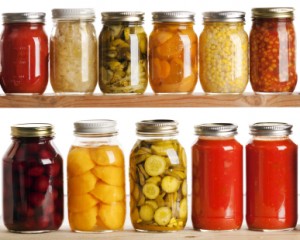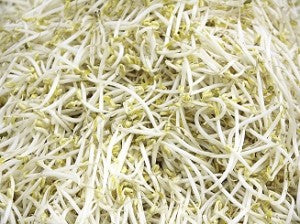The reason people have food storage is to provide food to sustain life during times when food is not readily available. Food availability may be determined by famine, lack of income, no transportation system, or major catastrophic events such as hurricanes, earthquakes, or floods. All living things must eat to stay healthy, so you may think that the foods you store must be of the highest nutritional content. While nutrition is very important, it is not the single most important thing to be concerned about when storing food.
The most important factor in food storage is the calorie content. Calories (energy) from food are needed most urgently and most regularly for health and living. Fortunately, anything edible will provide some amount of energy, but you can't live on just one food group alone. A variety of sources of products are needed to provide the nutrients for the body to properly use the energy in the food and to maintain good health. All foods lack one or more of the 40+ nutrients needed by the body; there is no one perfect food. Consequently, you need to eat and store a variety of different food items.
Your food storage program must be designed to sustain life. Here are a few suggestions for keeping life in your food storage program:
Storage
You must store your food items properly to keep your foods as fresh as possible. Only store food in food grade containers that can be tightly sealed to keep bugs and moisture out. Store the items as cold as possible for maximum shelf life. If you don't have a cellar or basement, store the items under your bed, on the floor of a dark closet, or in the lowest cupboard possible, away from your oven. Do not store food items, even when tightly sealed, next to gasoline, kerosene, chemicals, or household cleaning products. Storing food items near these things could result in tainted or poisoned food.
Rotation
Rotation of food storage items results in fresher foods being available to you and your family when the time comes to rely on food storage. Rotating what you have stored also allows your family to get used to food storage items as part of their regular diet. Fresher foods, whether frozen, canned, or pit stored have better quality and nutritional value. If stored food looks good and is convenient for use, it will be more likely to be rotated and eaten. Calories do not decrease with increased storage time. Protein quality in some foods does decrease very slightly due to interaction of some amino acids with carbohydrates resulting in a “browning reaction.” This is seen in enriched flour or nonfat dry milk that has been stored for long periods of time. The older product will be more brown or slightly tan in color compared to the newer, fresher product. This does not mean you can't use the product. Minerals are lost from stored food only by leaching or volatilization. Leaching involves liquid in some food storage items, such as canned items which could, over time, pass through the food and carry off some of the more soluble components. Leaching has no impact if the juices are eaten with the food that the juices come from. Volatilization deals with a food item turning into a vapor at relatively cold temperatures. At typical storage temperatures, iodine is the only mineral likely to volatilize, or vaporize, appreciably. For this reason, iodized salt should be stored as cool as possible and rotated regularly, so it doesn't lose its savor.
Variety
You've heard that “variety is the spice of life?” Well, there's no better way to prove it than to live on what you have stored right now. Maybe you have a lot of wheat stored. Can you imagine eating just wheat-made products for 2 weeks? Preparing meals which have a variety of color makes the meal more appetizing. Adding flavors and seasonings to the basic food storage items of grains and legumes will certainly make the foods taste better. A variety of colors can be added to your diet with fruits and vegetables. Flavor variations can be provided by fruit juices, spices or various extracts. Some spices and flavorings do not store for a long amount of time and must be rotated more frequently. Consider storing just-add-water desserts, such as puddings and fruit flavored gelatin. Desserts can really liven up your basic food storage.

Sprouting
Another great way to create variety and to liven up your food storage is by sprouting. This can be time consuming but can be done with your basic food storage setup. For an in-depth discussion on how to sprout grains and legumes, see the recent Insight article entitled Growing Your Own Food. You must remember not to allow your seeds to become too hot, too dry or to be stored in a completely oxygen-free environment. This will cause the seeds to fail to germinate. In order for germination to occur, the dormant endosperm must be able to maintain life. This requires oxygen and some moisture. If you are planning to sprout some seeds, consider storing some of your seeds in a container that is breathable and that allows for some degree of moisture. The seeds stored in this manner will not store as long, but will be great for rotating sprouts into your daily diet.

Insect Infestation
There is one form of life that is not wanted in your food storage – Insects! Some suggestions to avoid insect infestation are:
Buy storage supplies from a reputable supplier that are nitrogen or C02 packed.
Maintain cleanliness in your food storage area.
Seal stored foods in insect-proof containers to prevent future contamination.
Store the containers in a very cool (45-55°) and dry environment.
Rotate every five years.
Oxygen absorbers, bay leaves, and dry ice can all be effective.
Energy and nutrients obtained from foods help people sustain life. Through strategy and rotation, you can easily store foods that will not lose their nutritional and energy value.
Information obtained from published reports written by Dr. Deloy G. Hendricks, Ph.D.,
Nutrition Specialist, Cooperative Extension Service, Utah State University.



